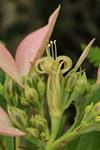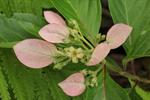Click the number at the start of a key lead to highlight both that lead and its corresponding lead. Click again to show only the two highlighted leads. Click a third time to return to the full key with the selected leads still highlighted.
1 Trees, shrubs, or woody vines. |
..2 Prostrate or climbing woody vines (lianas), or sprawling shrubs. |
....3 Leaf bases cordate, rounded, or truncate; leaves usually cordate, ovate, or deltoid shaped (occasionally hastate or broadly elliptic); corolla pale lilac colored; [non-native, se. US including FL; tribe Paederieae] |
....3 Leaf bases cuneate to rounded but not cordate; leaves oblanceolate, lanceolate or linear; corolla white or yellow; [native, FL]. |
......4 Flowers and fruit sessile or subsessile; fruit yellow |
......4 Flowers and fruit borne on pedicels or peduncles; fruit white |
..2 Shrub or tree, plants upright. |
........5 Inflorescence spherical or globular, in a tight round head; [collectively widespread] |
..........6 Fruits dry, dehiscent; [subfamily Cinchonoideae; tribe Naucleeae] |
..........6 Fruits fleshy, indehiscent; [subfamily Rubioideae; tribe Morindeae] |
........5 Inflorescence cymose, thyrsoid, or corymbose (the inflorescence more open, not round and compact); [Coastal Plain, from s. SC southward]. |
............ 7 Plants with paired spines. |
............ ..8 Corolla lobes 4; leaves to ca. 1 cm long; fruit ca. 5 mm long |
............ ..8 Corolla lobes 5; leaves ca. 2-5 cm long ; fruit ca. 10 mm long |
............ 7 Plants unarmed, not bearing spines or thorns. |
............ ....9 Flowers orange-red; leaves usually whorled; [subfamily Cinchonoideae; tribe Hamelieae] |
............ ....9 Flowers white, green, or maroon; leaves opposite. |
............ ......10 Leaves linear, revolute, and strongly congested; [FL keys southward] |
............ ......10 Leaves broad, not linear, nor strongly congested; [collectively more widespread] |
............ ........11 Flowers solitary, terminal; [subfamily Ixoroideae; tribe Gardenieae] |
............ ........11 Flowers in cymose or thyrsoid inflorescences. |
............ ..........12 Inflorescence cymose; some calyx lobes expanded into pink or reddish “flags”; leaves deciduous; domatia not present; [of s. SC southward]; [subfamily Ixoroideae; tribe Condamineeae] |
............ ..........12 Inflorescences thyrsoid; calyx lobes inconspicuous; leaves evergreen; domatia present in secondary vein axils; [of ne. FL southward] |
 Show caption*© Sequoia Janirella Wrens, some rights reserved (CC BY-NC), uploaded by Sequoia Janirella Wrens Show caption*© Sequoia Janirella Wrens, some rights reserved (CC BY-NC), uploaded by Sequoia Janirella Wrens ............ ............ 13 Lateral veins 3-6 on either side of the midvein; fruit white; petals yellowish, > 6 mm long; [subfamily Cinchonoideae; tribe Chiococceae] |
............ ............ 13 Lateral veins 8-14 on either side of the midvein; fruit red; petals white, <5 mm long; [subfamily Rubioideae; tribe Psychotrieae] |
1 Herbs (or creeping subshrubs in Mitchella). |
............ ............ ..14 Leaves whorled; [subfamily Rubioideae; tribe Rubieae] |
............ ............ ..14 Leaves opposite |
............ ............ ....15 Flowers paired, the ovaries connate and developing into a single fleshy red fruit; leaves roundish; creeping subshrub; [subfamily Rubioideae; tribe Mitchelleae] |
............ ............ ....15 Flowers single or in inflorescences with multiple flowers, the fruits either dry or fleshy and yellowish or black; leaves various; herb; [subfamily Rubioideae; tribe Spermacoceae]. |
............ ............ ......16 Carpels with few to many seeds. |
............ ............ ........17 Corolla 5-lobed |
............ ............ ........17 Corolla 4-lobed. |
............ ............ ..........18 Capsule longer than the calyx tube; flowers blue, pink, or white |
............ ............ ..........18 Capsule not longer than the calyx tube; flowers white |
............ ............ ......16 Carpels 1-seeded. |
............ ............ ............ 19 Flowers in dense, terminal, involucrate heads; flowers 4- or-6-lobed; styles 3 |
............ ............ ............ 19 Flowers in axillary or terminal clusters, or single in axils, not involucrate; flowers 4-lobed; styles 2. |
............ ............ ............ ..20 Flowers usually solitary in leaf axils; fruit separating into 2 parts. |
............ ............ ............ ....21 Sepals 4 and similar in size; style entire; [of dry habitats] |
............ ............ ............ ....21 Sepals 2 (or 4, and then markedly dimorphic); style cleft; [of moist to wet habitats] |
............ ............ ............ ..20 Flowers in terminal and axillary clusters; fruits not separating into 2 parts. |
............ ............ ............ ......22 Carpels opening transversely |
............ ............ ............ ......22 Carpels opening longitudinally |






